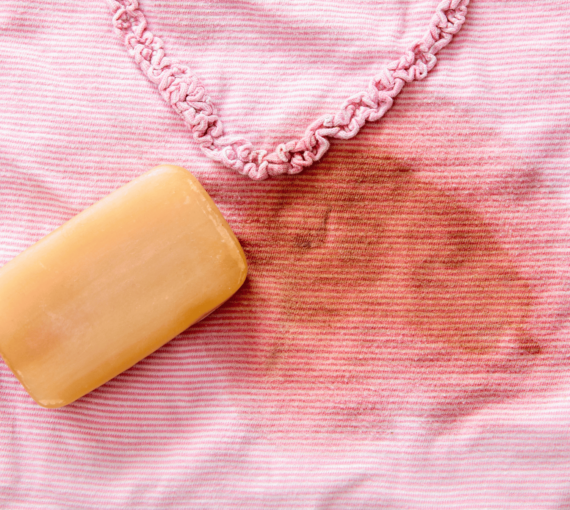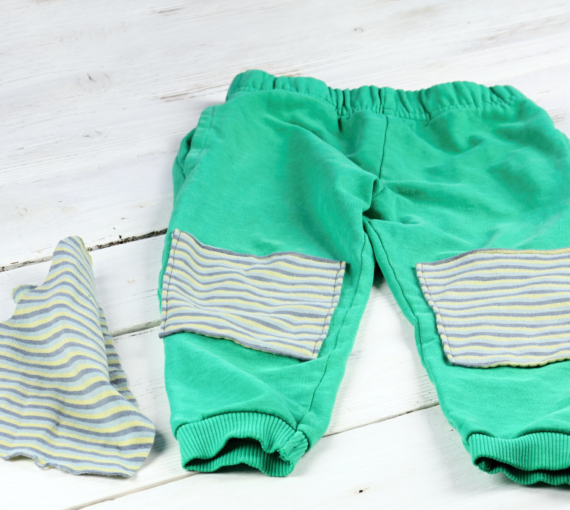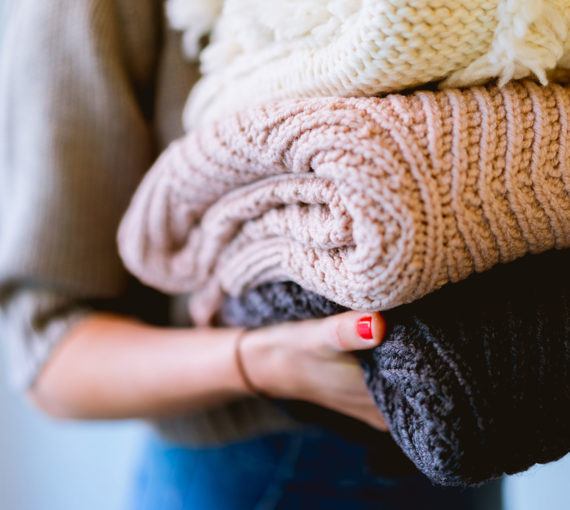
Having fun outdoors makes fond memories and sometimes stubborn grass stains on fabrics. Try eco-friendly ways to remove them.
Stains mark our adventures, misadventures and everything in between. A cloth napkin splashed with celebratory red wine. Grass-stained knees from a summer picnic. A turmeric smudge from a culinary experiment. Each carries a memory. While those memories may be precious and lasting, the stains don’t have to stick around.
If stains do stick around — don’t worry! The culture of perfection that pressures people to maintain a flawless, immaculate wardrobe demands an impossible ideal. It leads to overconsumption and waste. Every stain, tear and wrinkle tells a story and adds character to our garments. Embrace the imperfections.
For the stains you want to go, try an eco-friendly DIY method with inexpensive ingredients you may already have in your pantry and are often just as effective!
Impact of commercial stain removers on human health and the environment
Many commercial stain removers contain a cocktail of toxic ingredients that can trigger respiratory issues, hormonal disruption — even cancer. When these chemicals enter waterways or soil through our drains, they can disrupt ecosystems and harm flora and fauna.
How to get rid of common stains
Tip! Many DIY stain remover techniques can be used to spot treat carpets, upholstered furniture and fabric homewares. Before trying, research the fabric type and manufacturer’s cleaning recommendations to prevent further damage. Consider a test patch on an inconspicuous place.
Beet stains
Beets stains can be challenging due to their vibrant colour — they’re an excellent natural dye! Treat as soon as possible for best results.
- White vinegar. Soak the fabric in equal parts white vinegar and water for 30 minutes. Launder as usual.
- Lemon juice. Apply lemon juice directly onto the stain to help break it down. Let sit for five minutes. Gently scrub the stain with an old toothbrush. Rinse with cool water. Launder as usual.
Blood stains
Before trying any of these suggestions, soak the blood-stained fabric in cool water as soon as possible.
- Baking soda. Mix baking soda and water. Apply to the stain, gently rubbing it in. Let sit for an hour. Rinse with cool water.
- White vinegar. Pour white vinegar directly on the stain. Let it soak for 10 minutes. Blot with a cloth until the stain disappears.
- Hydrogen peroxide. For extra stubborn blood stains, apply a small amount of hydrogen peroxide. Rub gently with a clean cloth until the stain has lifted. Use sparingly as it can bleach some fabrics.
Coffee and black tea stains
Like beets, coffee grounds and black tea are great natural dyes, making stains difficult — but not impossible — to treat.
- Salt. Consider carrying a small to-go pack of salt for emergency stain fixes. Sprinkle salt on the stain. Let sit for a minute to soak up any residual liquid. Gently rub away with a cloth. This may not fully remove the stain, but should help prevent it from spreading.
- Baking soda. Mix baking soda and water. Apply to the stain, gently rubbing it in. Let sit for an hour. Rinse with cool water.
- White vinegar. Soak the fabric in equal parts white vinegar and water for 30 minutes. Launder as usual.
Fruit and juice stains
Treat as soon as possible, especially for tougher juices like cherry, pomegranate and berries.
- White vinegar. Soak the fabric in equal parts white vinegar and water for 30 minutes. Launder as usual.
- Hydrogen peroxide. Apply a small amount directly onto stubborn stains. Rub gently with a clean cloth until the stain has lifted. Use sparingly as it can bleach some fabrics.
Grass stains
Grass stains can be tricky, especially on cotton and wool. Grass compounds bind to the fibres so the stain sets inside the fabric, not on top.
- Baking soda. Apply a paste of baking soda and water to the stain. Gently rub in. Let sit for an hour. Rinse with cool water.
- White vinegar. Soak a sponge in white vinegar and scrub the stain out. Rinse with cool water.
Grease and oil stains
These can be tricky to remove the longer they sit and settle into the fabric. Treat as soon as possible.
- Baking soda. Cover the stain and area surrounding it with a generous amount. Let sit overnight. Baking soda’s alkaline properties should help soak up the grease and oil.
- White vinegar. If baking soda doesn’t work, soak the stain in a solution of equal parts vinegar and water. Let sit for a few hours. Launder as usual.
- Cornstarch. Like baking soda, cornstarch can be used to draw out grease and oil from fabric. Cover the stain and area surrounding it with a generous amount. Cornstarch is a mild abrasive, so scrub the stain gently. Let sit overnight. Launder as usual.
Marker stains
Marker stains, especially from permanent markers, can seem daunting because of the vivid colour transfer. But treated quickly, they’re easy to lift out of most fabrics.
- Rubbing alcohol. Dab onto the stain using a clean cloth. Continue to blot until the stain begins to lift. Rinse with cool water. Launder as usual.
Red wine stains
Treat wine stains promptly. Before trying any of these eco-friendly stain removal solutions, immediately blot the area to soak up as much wine as possible.
- Club soda. The fizzy drink is one of the quickest solutions to red wine stains. The soda’s carbonation helps dissolve the red pigments and lift the stain. Pour it on the stain. Let it fizz and soak for at least 10 minutes.
- Salt. Dab the stain with cool water. Sprinkle on a generous amount of table or kosher salt. The salt will soak up the wine and lift the stain away. For lighter stains, let sit for up to five minutes. For stubborn stains, leave overnight. Rinse thoroughly in cool water.
- Baking soda and white vinegar. Apply a paste of baking soda and white vinegar. Let sit for at least an hour. Rinse with cool water. Launder as usual.
- Boiling water. This is best for sturdy garments. Stretch the stained fabric tautly over a sink. Slowly pour the hot water over the affected area.
- White wine. If you have white wine on hand, pour a small amount over the red wine stain to neutralize and dilute it. Blot the area. Repeat as needed.

Don’t fall for “stain-resistant” labels on garments and furniture
“Performance textiles” are designed to be durable and resistant to stains, water, mould and/or fading. Many are treated with PFAS (a.k.a. “forever chemicals”), a blend of synthetic chemicals linked to many health concerns, including organ damage, immune disorders, reproductive and developmental difficulties, cancer and hormone disruption. A 2022 study by Toxic-Free Future found PFAS in 72 per cent of tested products labelled stain- or water-resistant.
The good news? They didn’t find PFAS in any of the tested items not marketed as stain- or water-resistant.
Sweat stains
Sweat stains often need extra effort because they develop over time. Most are caused by a reaction between the salt, proteins and oils in sweat and deodorant ingredients.
Tip! A great way to reduce the likelihood of sweat stains is to make sure your deodorant is aluminum-free.
- Lemon juice and salt. Apply a generous amount of both on stained areas. Let soak in. Rub with a clean sponge or cloth until the stain disappears. Air dry clothes in the sun to enhance the lemon juice’s bleaching power.
- White vinegar. White vinegar’s neutralizing effects remove stains and odours well — great for athletic wear! Immerse the fabric in equal parts white vinegar and water. Let soak for 30 minutes. Launder as usual.
Tomato sauce stains
Carefully scrape off excess sauce. Treat with a DIY stain remover to keep the stain from spreading and sinking deeper into the fabric.
- Baking soda. Apply a paste of baking soda and water to the stain. Gently rub in. Let sit for an hour. Rinse with cool water.
- White vinegar. Soak fabric in equal parts white vinegar and water for 30 minutes. Launder as usual.
Turmeric stains
Turmeric adds vibrant colour to foods — it’s a natural dye! — and is challenging to remove from fabric. Treat the stain as soon as possible, before the pigment sets in.
- Baking soda. Apply a paste of baking soda and water to the stain. Gently rub in. Let sit for an hour. Rinse with cool water. Soak in white vinegar.
- White vinegar. After rinsing the baking soda paste, submerge the stained fabric in white vinegar. Wring and repeat as necessary. Once the stain lessens significantly, launder in cool water.

Eco-friendly commercial stain removers
If you’re looking to buy a commercial stain remover, choose an eco-friendly, biodegradable product free of harmful chemicals.
Examples of eco-friendly commercial stain removers:
- Stain removal sticks. Often found in health food grocers or zero-waste shops, these are typically made of a blend of vegetable-based soap and glycerin. They’re often low cost and low waste.
- Plant-based stain remover. Many green cleaner product lines include plant-based stain removers. These contain enzymes that break down stains at a molecular level without damaging fabrics.
Tip! Pre-treat tough stains with the DIY removal method appropriate for the type of stain.

Stubborn stains? Upcycle!
If you can’t remove a stain, don’t landfill the fabric! Look for opportunities to give it a second life. Cut it up into rags for messy projects such as car repairs, painting, gardening, etc. Use unsoiled parts for sewing, arts and crafts projects or patches to repair tears.
How to whiten clothes
You don’t need liquid bleach or borax to whiten and brighten. Try an eco-friendly method to lift discolouration and refresh your whites:
- Liquid or powdered oxygen bleach. Made of hydrogen peroxide and water, this alternative to chlorine bleach is kinder to the environment and just as effective! Find it in the laundry aisle of your local retailer. Follow the laundry instructions on the package. Warning! Never mix liquid or powdered oxygen bleach with vinegar. The combination is potentially toxic and corrosive.
- Baking soda. Add 125 ml (½ cup) baking soda into a laundry load of whites. For tougher stains, soak white clothes in hot water and baking soda overnight before laundering.
- Washing soda. Add two tablespoons of washing soda to a laundry load of whites. Washing soda is more caustic and has a higher pH than baking soda.
- Hydrogen peroxide. The oxidizing agent can be used as a mild bleaching agent. Use the three per cent solution sold in most drugstores. Add 250 ml (one cup) to the washer’s bleach dispenser. Launder as usual.
- Sunshine. UV rays can brighten white garments and are naturally antibacterial. Hang freshly washed clothes in direct sunlight to dry.



